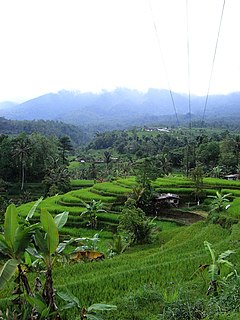 W
WLand art, variously known as Earth art, environmental art, and Earthworks, is an art movement that emerged in the 1960s and 1970s, largely associated with Great Britain and the United States but also includes examples from many countries. As a trend, "land art" expanded boundaries of art by the materials used and the siting of the works. The materials used were often the materials of the Earth, including the soil, rocks, vegetation, and water found on-site, and the sites of the works were often distant from population centers. Though sometimes fairly inaccessible, photo documentation was commonly brought back to the urban art gallery.
 W
WA berm is a level space, shelf, or raised barrier separating two areas. It can serve as a fortification line, a border/separation barrier, in industrial settings, or in many other applications. The word berm originated in Middle Dutch and came into usage in English via French.
 W
WThe Cascades is a manmade waterfall attraction in Sparks Foundation County Park, Jackson, Michigan. The falls are both illuminated and choreographed and is the site of concerts and special events from Memorial Day to Labor Day. Three times a year, Memorial Day, Independence Day, and Labor Day, fireworks displays are presented at the Cascade Falls. Since its creation in 1932, millions of people have enjoyed the beauty of The Cascades.
 W
WA constructed wetland (CW) is an artificial wetland to treat municipal or industrial wastewater, greywater or stormwater runoff. It may also be designed for land reclamation after mining, or as a mitigation step for natural areas lost to land development.
 W
WA polder is a low-lying tract of land that forms an artificial hydrological entity, enclosed by embankments known as dikes. The three types of polder are:Land reclaimed from a body of water, such as a lake or the seabed Flood plains separated from the sea or river by a dike Marshes separated from the surrounding water by a dike and subsequently drained; these are also known as koogs, especially in Germany
 W
WLand reclamation, usually known as reclamation, and also known as land fill, is the process of creating new land from oceans, seas, riverbeds or lake beds. The land reclaimed is known as reclamation ground or land fill.
 W
WIn agriculture, a terrace is a piece of sloped plane that has been cut into a series of successively receding flat surfaces or platforms, which resemble steps, for the purposes of more effective farming. This type of landscaping is therefore called terracing. Graduated terrace steps are commonly used to farm on hilly or mountainous terrain. Terraced fields decrease both erosion and surface runoff, and may be used to support growing crops that require irrigation, such as rice. The Rice Terraces of the Philippine Cordilleras have been designated as a UNESCO World Heritage Site because of the significance of this technique.
 W
WAn artificial waterfall is a water feature or fountain which imitates a natural waterfall.